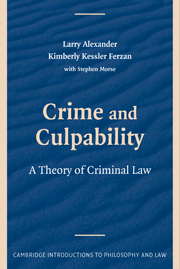1 - Criminal Law, Punishment, and Desert
Published online by Cambridge University Press: 05 June 2012
Summary
Ultimately, what underlies the criminal law is a concern with harms that people suffer and other people cause – harms such as loss of life, bodily injury, loss of autonomy, and harm to or loss of property. The criminal law's goal is not to compensate, to rehabilitate, or to inculcate virtue. Rather, the criminal law aims at preventing harm.
This admission may seem puzzling, given that the authors of this book have argued in previous writings, and will continue to argue here, that whether a criminal defendant actually causes harm is immaterial to whether he should be deemed to have violated the criminal law and is likewise immaterial to the amount of punishment he should receive. But these claims do not entail that the criminal law is not ultimately concerned with harm causing. Quite the contrary.
The Criminal Law and Preventing Harm
To explain how we can admit that the criminal law's primary concern is the prevention of harm yet still maintain that the actual occurrence of that harm is immaterial, we will begin by exploring ways that harm might be prevented. One way to prevent the harms with which the criminal law is ultimately concerned is to make the causing of harms to others more difficult. There are three strategies for doing this. One strategy is to increase the difficulty of causing harm by increasing the effort or natural risk required to cause harm. We put money into safes that are difficult to crack.
- Type
- Chapter
- Information
- Crime and CulpabilityA Theory of Criminal Law, pp. 3 - 20Publisher: Cambridge University PressPrint publication year: 2009



